‘Open’ exhibition which was on display at two universities – the University of Social Science and Humanity and University of Law - last week will continue to tour four more universities in Vietnam's capital Hanoi this month.
Organisers hope the exhibition, with the tagline ‘Open mind, Open life’, promotes understanding and acceptance, and reduce stigma and discrimination of LGBT people in Vietnam. The exhibition will next be displayed be at Thang Long University (15-16 April), Forestry Univesrity (20 April), University of Sport Teaching (21 April) and Hanoi College of Transportation (27-28 April). Organisers also told Fridae that they hope to exhibit in 10 universities in Hanoi and eventually have the exhibition tour Da Nang in the central region of Vietnam and Ho Chi Minh City in the south.
The exhibition, which comprises 98 photographs, is organised by the Institute for studies of Society, Economy and Environment (iSEE) in association with the Information Connecting and Sharing group (ICS), a voluntary group of LGBT rights advocates. A play will also be staged at each exhibition venue.
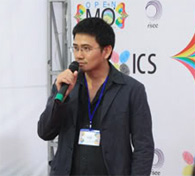
Le Quang Binh, head of iSEE, an independent, non-profit think-tank working exclusively on issues of human rights of minority groups in the society, tells Fridae’s Sylvia Tan over email about what the exhibition hopes to achieve, and gay life in Vietnam today.
æ: Tell us more about the OPEN exhibition.
The images are all about life, love and relationships of gays. For example, the series titled “Third gender” by Phan Nha Trang is about men who dare eat ‘forbidden apples.’ However, love triumphs and they find love at the end.
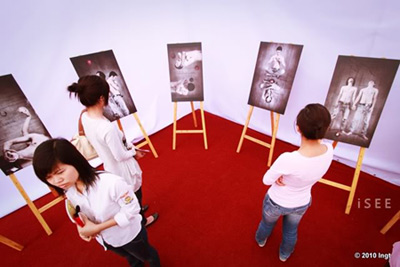
“Third gender” by Phan Nha Trang
In the series “Crossroad” by Tung, traffic signs are used as a metaphor to illustrate the internal struggles of gay men who are trying to find themselves. Standing at the crossroads, he is caught between going 'straight' as expected by the society and families, or leading a life true to his gay sexual orientation. At the end, he follows his heart and as he knows the path to happiness is to lead his true life.
æ: What are the objectives of the exhibition and play?
There are two main objectives of this event. Firstly, we aim to change the attitudes of society, especially students and young people about homosexuality. We hope for the exhibition and play to create dialogue about homosexuality; visitors will also have access to unbiased information about homosexuality. Secondly, we want the LGBT community in Hanoi to have a chance to work together for the good of the greater community.
We chose to organise these events at universities because the students are likely to be future leaders of Vietnam who would be able foster a society where sexual minorities are respected and protected. In addition, we hope that we are able to create a learning environment that is tolerant of diversity that would allow gay and lesbian students a better environment to study and be themselves.
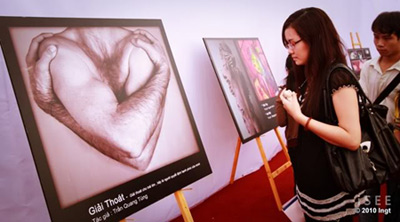
æ: Did the organisers have any difficulty in organising the exhibition and play?
Many people asked me about the application process for the permit from Hanoi Department of Culture, Sport and Tourism as they thought it would be difficult to get the permit to organise a public event about homosexuality in universities in Hanoi. However, we did not face any difficulties in this process. We submitted all necessary documents and photos to the authorities and they agreed for us to organise it. I think the photos and play are about the diversity life, love and sexuality and therefore it is easier for the authorities and universities to cooperate. This is our approach in Vietnam – to focus on diversity of life and love rather than just emphasising the difference between homosexual and heterosexual relationships. In each university, we also receive support from University Youth Associations and the university management.
One or two universities have refused to organise this event saying that they already have a very busy schedule of events. I did not have chance to talk with them directly about this but I hope they are truly busy, not because they did not want to be involved due to the subject matter.
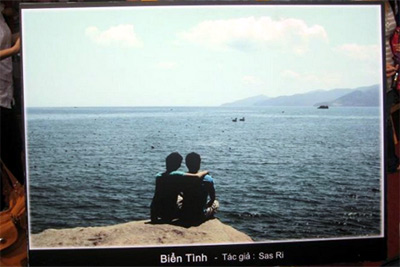
æ: Can you tell us more about iSEE?
iSEE is an independent, non-profit think-tank which works exclusively on issues of human rights of minority groups in the society. iSEE envisions a prosperous, free, diverse, democratic, just, and civilised society where minorities are treated equally. iSEE aims to become the leading think-tank in social inclusion and rights of minorities in Vietnam. Currently, iSEE focuses on two main groups: LGBT and ethnic minorities. iSEE strives to protect the rights of minorities by:
- Conducting high quality research on their issues using the rights-based approach.
- Lobbying and advocating for their rights.
- Improving public understanding and tolerance of diversity.
- Empowering minorities and the socially excluded to protect their rights.
æ: What are the students' / university staff's response to the exhibition?
About 2,500 students visited the exhibition and 300 students watched the play in University of Social Science and Humanity-Hanoi. Although some students had thought homosexuality to be associated with diseases such as HIV and homosexuality is not acceptable, almost all students appeared to have a very positive and supportive attitude towards the exhibition. Many of them wrote about their feelings on the exhibition notebooks.
For example, Thuong, a student of class K54 Anthropology, said: “It is no shame. Live like the wind! Once you believe in yourself – we’ll believe in you too!” A student named Oanh said: “Homosexuality is not guilty. Dare to speak the truth and face your true self – you are the most wonderful people! Wish you happy life!”
One Chinese student On Chu Du said: “I first had a strange feeling when I visited the exhibition however I’ve changed my attitude towards homosexual love. Through this event, I’ve also learned about Hanoi students who are active and passionate. Thank you so much!”
The event was generally favourably covered by more than ten national newspapers and television programs. Dieu Linh, a journalist from Capital Women said: “OPEN is not just a journey to seek self-emotion but open the door to the whole world. OPEN is not just the journey to confirm one’s sexuality but it is a battle for love, happiness of many people. Hope when you open your heart you will find your happiness.” These messages are a great source of support for us, the LGBT communities, to run our exhibition and play in other universities.
Gay students who visited the exhibition also found it inspiring. Linh89 wrote on taoxanh.net: “My classmates visited the exhibition and one said ‘it is so unpleasant to organise an exhibition to encourage homosexuality’. I was about to respond to him but the others went ahead and explained it to him that the OPEN exhibition is giving great opportunity for people to discuss homosexuality.”
One of our collaborators also told me that one gay student came out to his mother that evening after visiting OPEN. He gave his mother the materials about homosexuality and on the second day became a guide at the exhibition giving other students tours.
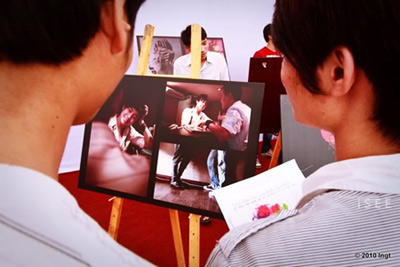
æ: What is the gay "scene" like in Hanoi today?
There are very limited venues for LGBTs to gather in Hanoi. The most popular are online communities such as www.taoxanh.net, www.tinhyeutraiviet.com, and www.bangaivn.net. The total number of registered members are in the hundreds of thousands and many find friendship and support through these networks.
There are some international NGOs that specifically work with men who have sex with men (MSM) from a public health/HIV perspective. These organisations have set up self-help groups of MSM to focus on HIV prevention. There are very few organisations working with LGBTs. To my best knowledge, Center for Studies and Applied Sciences in Gender, Family, Women and Adolescents (CSAGA) is a very good NGO working on gender equity and domestic violence, and has a project for lesbian women. They provide telephone counselling services to lesbians and their families. Consultation of Investment in Health Promotion (CIHP) is also a very good NGO working on public health and HIV issues, and also conducts research on the historical perspective of homosexuality.
Information Connecting and Sharing group (ICS) together with their collaborators in Hanoi and Ho Chi Minh City organised the exhibition for public education purposes. ICS is currently a voluntary group of LGBT leaders but is working towards obtaining legal status to operate as an independent organisation by the end of the year.
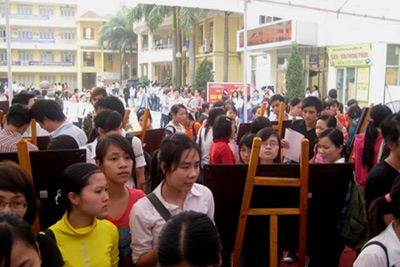
The exhibition at the University of Social Science and Humanity drew a crowd.
æ: To what extent is Vietnamese society tolerant or accepting of LGBT people?
We are carrying out a survey to measure the social stigma and perception about LGBTs. I hope by the end of this year we will have a better answer to your question.
However, according to a survey (sample size: 3000) conducted by iSEE last year, about 95 percent of gay men participated said they have heard others say that homosexuality is ‘abnormal,’ 19 percent said that their friends abandoned them for being gay and about 15 percent of them were scolded by their family for being gay. However, the percentage experienced physical abuse for being gay is lower and about 4.5 percent.
I think the causes of stigma against LGBTs in Vietnam are due to one’s ignorance of homosexuality. Many people believe that homosexuality is ‘abnormal’ and some even think it is a ‘disease’ and ‘contagious.’ According to our media coverage analysis of homosexuals in 2008, 41 percent of articles about homosexuality is negative. Among the articles that attempted to explain the ‘cause’ of homosexuality, 80 percent said that homosexuality is caused by a ‘contagious disease, fashion, curiosity, rape, or fate.’
From this lack of understanding, people feel afraid and have negative attitude towards homosexuals. However, Vietnam does not have any legal framework that discriminate or criminalise homosexuals. We do not have religious homophobia (at least I’ve never heard of homophobia in relation to religion in Vietnam). Therefore, I think change can happen quickly if we have right strategies to raise awareness for the public. This is why iSEE and ICS focus very much on media and public education activities like the OPEN exhibition and the play. In addition, we have conducted training on sexual diversity for journalists who write about homosexuality. We are also training other organisations such as Women’s Union, and other development agencies so they can spread the knowledge widely. We also use other channels such as brochures, television and on-line media (Facebook, websites and blogs) to talk about homosexuality and diversity of life.
The exhibition will displayed be at Thang Long University (15-16 April), Forestry Univesrity (20 April), University of Sport Teaching (21 April) and Hanoi College of Transportation (27-28 April).











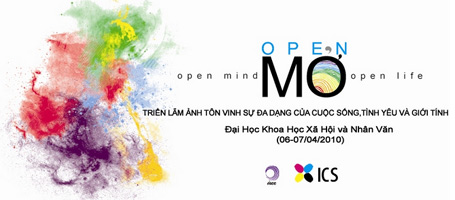
 Printable Version
Printable Version
















